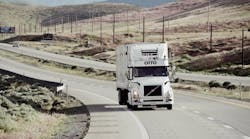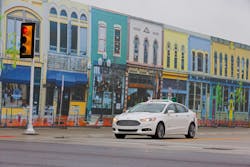The ongoing effort to develop self-driving trucks is starting to involve a very heavy dose of irony, for the very industry being targeted for automation currently has no input into designing the rules that will govern how said automation is ultimately deployed.
Chris Spear, the newly-installed president and CEO of the American Trucking Associations (ATA), brought this subject up at the trade group’s annual convention in Las Vegas this week [go here, here and here for more on that gathering] and it’s not a pretty issue by any stretch of the imagination.
“Autonomous vehicle technology is real, folks, and it’s here whether we like it or not,” he said during his inaugural speech at the conference. “If properly developed, it has the potential to dramatically improve safety and reduce [traffic] congestion – and as an industry, trucking loses $49.6 billion a year to congestion.”
All well and good, but Spear and ATA are none-too-pleased about how autonomous vehicle policy is being developed with zero input from truckers.
“The playbook for how autonomous technology will be regulated is currently being written by automotive OEMs and their federal and state regulators,” Spear stressed. “The trucking industry cannot afford to concede and entire regulatory framework to another mode of transportation, especially one that we’ll ultimately inherit.”
And while all the benefits of autonomous vehicles may “sound appealing,” in Spear’s words, “they won’t happen if we’re not at the table.”In an interesting twist, ATA invited John Bozzello, president and CEO of the Global Automakers trade group (someone Spear worked closely with while in a prior stint as vice president of government affairs for Hyundai Motor Co.) to its yearly gathering to discuss autonomous vehicle trends.
Bozzello sought to illuminate just two of the many reasons why there’s been a big push to make autonomous vehicles a reality:
- Highway deaths due to vehicle crashes are on the rise and in 94% of vehicle crashes, human error is to blame. Thus if vehicles drive themselves and take humans out of the equation, mayhap fewer crashes and deaths will be the result.
- More efficient machine-led driving should lead to less traffic congestion, less fuel consumption, and dramatically lower vehicle exhaust emissions.
One stumbling block facing the deployment of driverless vehicles centers on a rather mundane yet critical point: the lack of a dedicated “communication spectrum” so vehicles to “talk” to one another.
Bozzello noted that this “spectrum” issues is one reason positive train control (PTC) technology mandated by Congress for the rail industry back in 2008 and supposed to be in place by the end of 2015 still faces significant delays.
“There is just no spectrum available,” he explained. “The danger is that the spectrum we need will be lost if the FCC [Federal Communications Commission] uses it in favor faster download speeds versus highway safety.”
One would think trucking would be a good ally to have in this fight to secure spectrum space, if the industry – in the words of ATA’s Spear – gets “a seat at the table.”
In follow-on press conference with reporters at the trade group’s convention, he laid out a very stark policy reality facing the industry where self-driving trucks are concerned: “I tell you, we [in trucking] are not at equal pace with the automotive industry on this [autonomous technology],” Spear said.
“And not only are we not at the [policy] table, we’ve not even been invited to the table,” he added. “We see the values this [autonomous technology] can bring to our industry: greater safety, less fuel burned, less environmental impact, less traffic congestion, and making the job of [truck] driver more attractive.”
But to make any of that become reality, Spear emphasized trucking needs to be involved in the policy process.
“On one point we all agree: this technology is here and it is not going away,” he said. “The regulators need our advice on this, good or bad, and to do that we need to be involved.”
We’ll see if that happens.





